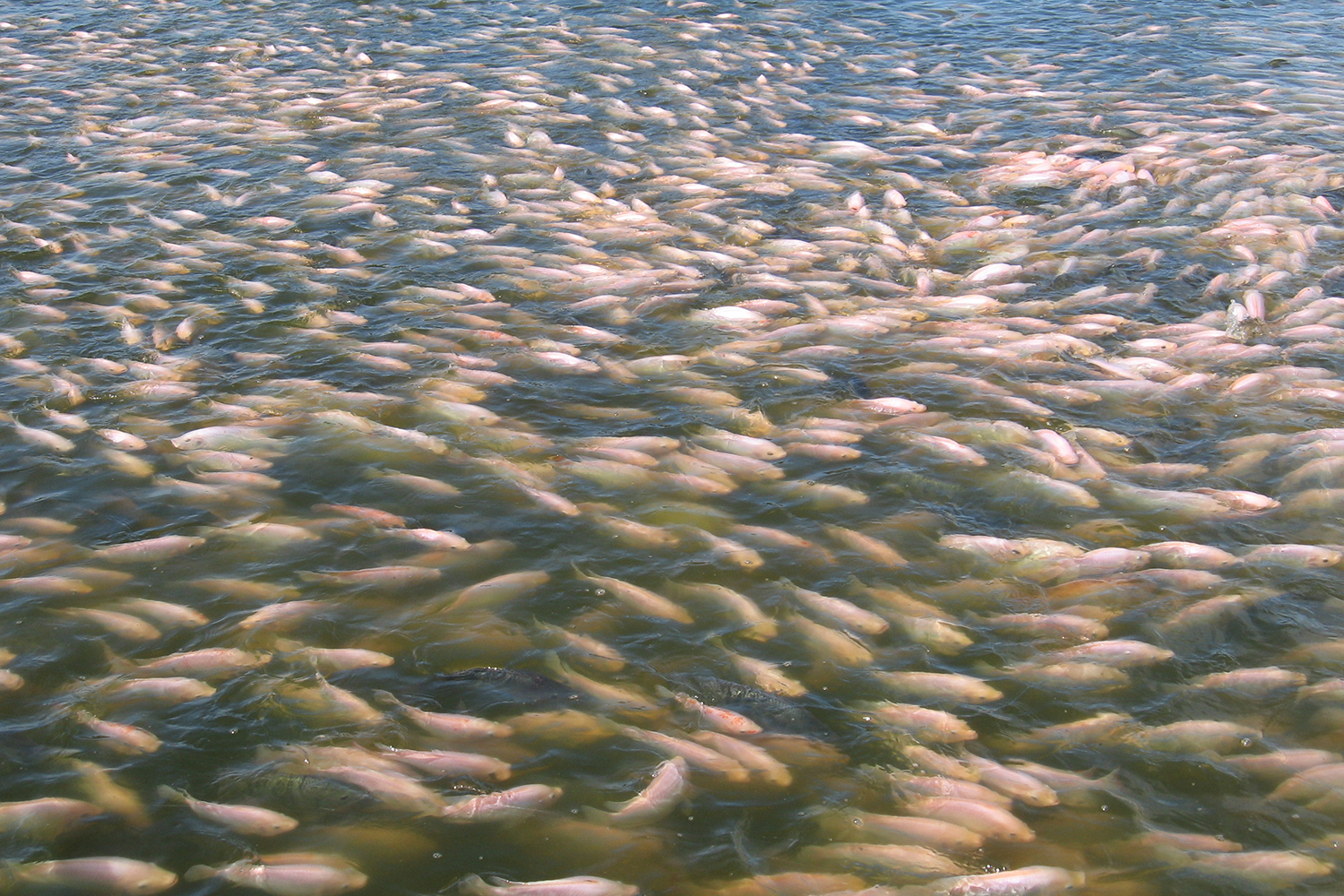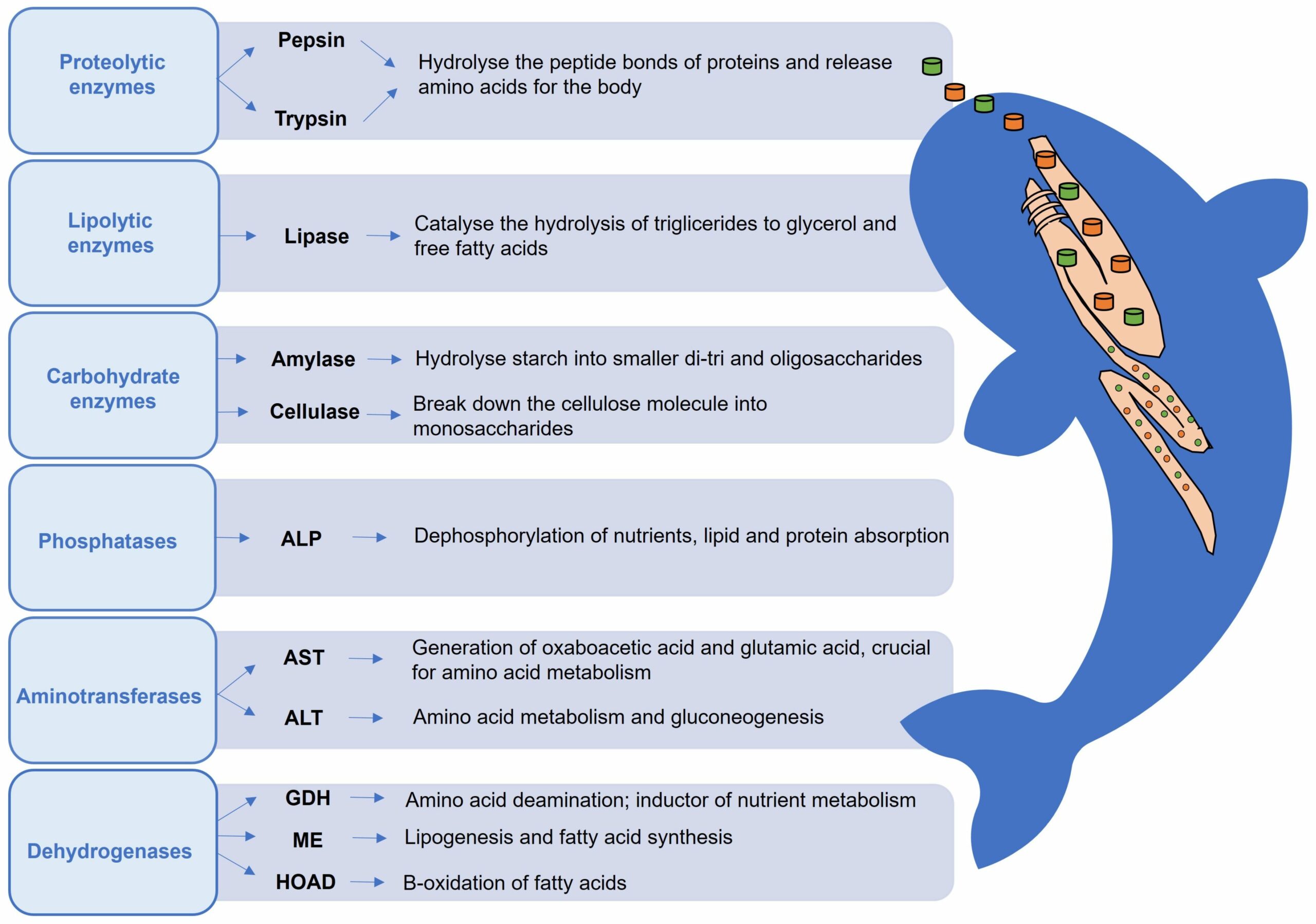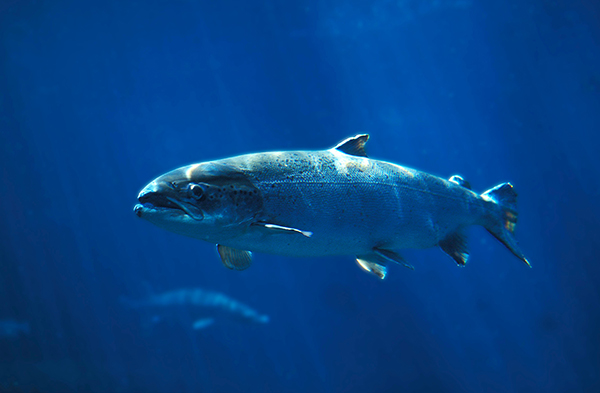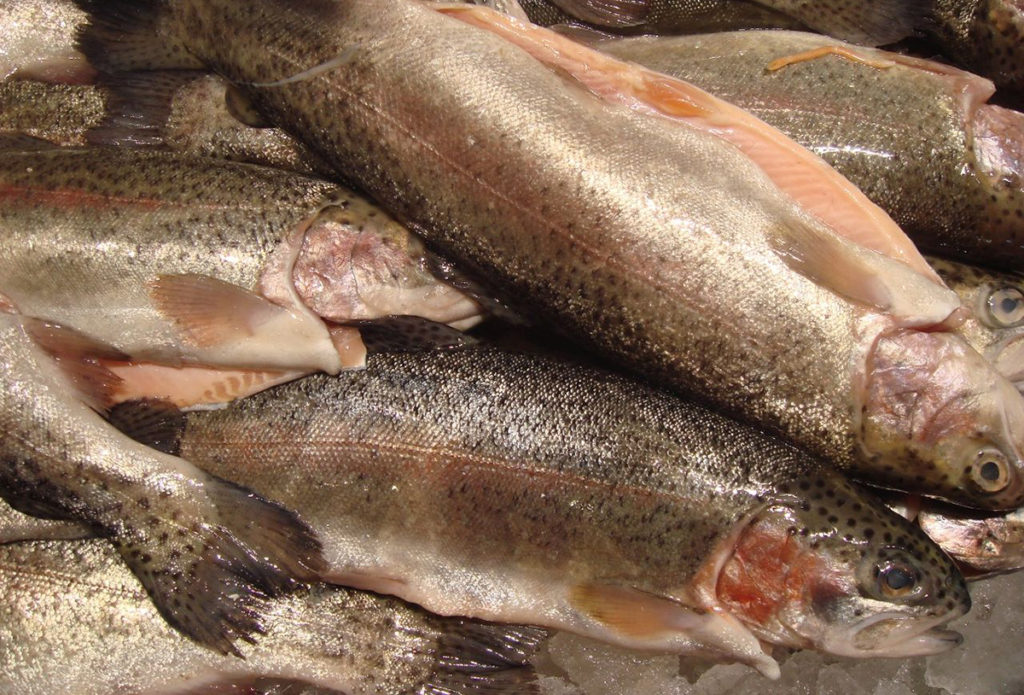A discussion of the use of biomarkers in fish aquaculture and research, and the main omics technologies available for further biomarker studies

A biomarker is any measurable indicator of a biological state. The World Health Organization has defined biomarkers as “almost any measurement reflecting an interaction between a biological system and an environmental agent, which may be chemical, physical or biological.” Over the years, biomarkers have been successfully applied in human health or environmental conditions studies and have been refined to more accurately respond to research needs.
When applied in fish production, biomarkers provide information on physiological and metabolic processes and relate them to fish welfare, health, reproduction, and growth. A biomarker also allows a fast understanding and detection of the effects of changes in production practices on fish stress and health, allowing for rapid corrections and the introduction of improvements in production management.
Biomarkers used for fish health and welfare include metabolism biomarkers (enzymatic activity, hormones, metabolites and others); oxidative stress biomarkers (enzymes, heat shock proteins and others); immunological biomarkers (innate immune enzymes, cytokines, and others); biochemical biomarkers (plasmatic cortisol, glucose, lactate and others); and mucosal and mucin-associated biomarkers (mucins, goblet cells, rodlet cells and others). For detailed information on these, refer to the original publication.
This article – summarized from the original publication (Oliva-Teles, A. et al. 2024. Tracking Biomarkers for the Health and Welfare of Aquaculture Fish. Fishes 2024, 9(7), 289) – reviews the application of biomarkers in aquaculture studies and the emerging methods and technologies that can support and improve the fish health evaluation process.
Biomarkers in aquaculture nutrition studies
With aquaculture production increasing, studies on how dietary nutrients and ingredients affect such parameters are becoming increasingly important. For example, the use of functional ingredients in aquafeeds is a strategy to improve novel aquafeed utilization and improve fish performance, health and immune and oxidative status. Functional ingredients are characterized by having added value beyond nutritional requirements and can be micronutrients (some minerals and vitamins), macronutrients (such as some amino acids), antioxidants and immunostimulants (like algae and plant extracts), or supplements used to alleviate the effects of antinutritional factors commonly found in plant feedstuffs.
However, novel feeds can have cumulative negative effects and result in less-than-optimal health. Therefore, with the recent increase in new dietary formulations, researchers have turned to testing whether different diets can influence fish health and welfare, using and developing different biomarkers to better understand the connection between feeds, nutrients, and physiological processes.
The black soldier fly (Hermetia illucens; HM) is an example of a novel feed ingredient extensively studied as a fishmeal and fish oil replacement in the diets of various fish species. For instance, to evaluate the dietary inclusion level and the metabolic effects of HM in diets for meagre, several markers such as plasma glucose and various enzymes and their activity have been evaluated. For enzymes, results showed that various alkaline protease activity increased, and trypsin activity decreased with higher HM inclusion, indicating that the replacement of fishmeal with HM should not exceed 17 percent to avoid adverse effects on digestive enzyme activity. Using similar markers, other researchers showed that HM could replace up to 19.5 percent of fishmeal in diets for European seabass, while not affecting digestive enzyme activity.
Mucins (proteins produced by skin tissues in most animals) are mostly present in the posterior intestine and are also good biomarkers of the effects of alternative ingredients. For instance, in gilthead sea bream it was shown that a specific mucin was less expressed when fish were fed a vegetable oil-based diet as opposed to fish oil. On the other hand, in Nile tilapia, mucin-like protein expression was up-regulated by limonene (a major component in the essential oil of citrus fruit peels) supplementation in diets, and in Atlantic salmon, the expression of a specific mucin was up-regulated in fish fed a fermented soybean meal diet.
These and several other studies are examples of the variability of biomarker responses in different fish species fed similar ingredients, highlighting the relevance of using more than one biomarker to more precisely evaluate the searched response. Additionally, biomarkers can be also used to uncover the effects of fasting or feeding strategies in fish.
Biomarkers in aquaculture stress studies
In captivity, particularly under intensive production, fish are often exposed to stressful situations such as crowding, handling, transportation, poor water quality, hypoxia, and others, which can lead to disease outbreaks. Under such stressful circumstances, fish responses can vary depending on species, rearing conditions, type, and level of stress. Due to the highly variable responses, it is important to find reliable methods to measure stress levels; this is an instance in which biomarkers can be extremely useful. Stress responses are generally regulated by the neural, endocrine and immune systems, in which stress biomarkers can be searched.
For example, when Artic charr were subjected to chronic heat exposure, the expression of heat stress proteins (well- known stress biomarkers) increased, dropping as soon as the heat exposure was over, showing the potential of these proteins as biomarkers of thermic stress in this species.
Mucins can also be useful biomarkers of stress on fish. For instance, in Atlantic salmon, subjected to short-term (handling) and prolonged exposure (high stocking densities) to stress, mucin transcription varied both with stress conditions and tissue analyzed. During short-term stress, mucin transcription was up-regulated in the gills but down-regulated in the intestine and skin, probably as a result of imbalances in the metabolic costs due to stress. On the other hand, after prolonged stress, mucin transcription was up-regulated in the skin but not in other tissues analyzed. This indicates that mucins may be useful as tissue-specific biomarkers for the evaluation of the effects of stressful situations.

Biomarkers that evaluate stress effects on fish physiology at a molecular level can also be very important in improving production. For example, a study on how handling stress and water temperature affected yellow perch evaluated several biomarkers and showed that handling stress and salt treatment heightened these stress biomarkers at a water temperature of 26 degrees-C when compared to 20 and 14 degrees-C conditions.
Biomarkers in aquaculture infectious diseases studies
Biomarkers can help with the early detection of immune status depression induced by stressors that make fish more susceptible to pathogens and detect the onset of pathogenesis before any symptoms or lesions occur, helping to early combat disease, avoid its spread in the facilities, and avoid antibiotic use. Biomarkers can also be important to understand differences in the immune responses between survivors and victims of disease.
Although blood is the most studied biological fluid for biomarkers of disease in humans and farm animals, only a few studies have focused solely on its use to uncover potential biomarkers of disease in fish. For instance, in Atlantic salmon the serum proteome profile was used for finding biomarkers triggered by pancreatic disease caused by a virus. In another study, the enzyme enolase was also validated as a non-lethal biomarker for white muscle myopathy triggered by pancreatic disease. The serum levels of other enzyme biomarkers have been shown to correlate well with heart and skeletal muscle inflammation and cardiomyopathy.
A proper understanding of the immunoregulatory function of the intestinal epithelium could also provide relevant information for the development and improvement of strategies for the prevention and treatment of pathologies and to establish biomarkers of pathogenicity. For instance, in grass carp, besides inducing histological alterations, infection with Aeromonas hydrophila provoked intestinal inflammation as confirmed by the increased expression of various enzymes.
Aquaculture and Aeromonas hydrophila: A complex interplay of environmental factors and virulence
Advancing biomarkers through omics technologies
Omics, such as genomics (gene analysis), transcriptomics (messenger RNA analysis), proteomics (protein analysis), and metabolomics (metabolite analysis), are used to study structures, functions, interconnections, and dynamics of biological molecules within organisms. By providing information on the biological system, from molecules to the whole animal, omics helps to identify key molecules of the complex molecular mechanisms of biological processes and understand their performance under different conditions. Thus, omics are important tools for the discovery and validation of biomarkers for fish health, using a systems biology approach.
In recent years, omics have gained attention, and their increasing application in aquaculture research has provided important information on fish health and welfare. Different techniques can be used within each omics, and recent developments in analytical methods have provided researchers with highly efficient and accurate methods of analysis that provide a huge amount of information. The data obtained within each omics approach can be integrated, using computational biology and bioinformatics tools, to connect the identified molecules with the appropriate biological mechanisms, thus improving and validating various biomarkers.
Genomics focuses on the study of the genome of organisms, and its objective is to sequence, assemble, and analyze the structure and function of the genome. Transcription, as related to genomics, is the process of making an RNA copy of a gene’s DNA sequence used for synthesizing an encoded protein. Transcriptomics analyzes gene expression by quantification of transcripts. By providing information on the expression of genes associated with growth, reproduction and other processes, the analysis of RNA transcripts can be very useful in aquaculture, as it allows for the discovery and quantification of molecular markers related to many traits.
The use of proteomics has been relevant to uncovering important physiological molecules relevant as biomarkers for fish health and welfare, and environmental stress. Proteomic technologies allow for the identification and quantification of translated proteins that are present in the fish at a certain moment and allow for the evaluation of changes in protein activity in response to alterations in fish’s physiological status. Proteomics allows the discovery of key proteins that are differently synthesized, degraded or modified by external factors such as diet, pathogens, and environmental conditions.
Metabolomics aims to unveil metabolites and their related chemical processes. Since metabolites are the end products of cellular processes, they are key indicators of how biological systems react to exogenous influences. In a metabolomic analysis, it is possible to limit the identification and quantification to a pre-defined selection of metabolites from a particular biological sample and focus on their specific chemical properties. Metabolomics can help to obtain more information on the connection between health, welfare, nutritional status and adaptation to the environment, and thus help the identification of biomarkers for monitoring fish health, stress, and nutritional status.
Other more recently developed omics technologies include lipidomics studies the lipidome, which consists of the set of lipids of a cell or organism, and allows for the analysis of the structure, function and interactions of lipids. Phenomics studies phenomes, the physical and biochemical traits of an organism, which can be altered due to genetic mutations and environmental effects on the genome. Microbiomics comprises the study of the microbiome, which can provide important information, for instance, on how dietary modifications or the environment affect fish health and immunity through microbiota modifications and interactions. And nutrigenomics studies the effects of nutrients on gene expression and the resulting alterations in fish metabolism and health.
Despite its increased application in aquaculture research, there are still obstacles to the wide use of omics technology. To this day, omics remain a high-priced analysis, often not easily accessible in some research and production scenarios. Additionally, the data obtained can be complex, requiring complex analytics programs and expertise for its interpretation. Moreover, the characterization of the genome, transcriptome, proteome and metabolome is a delicate task, demanding particular care with sampling and experimental design.
Perspectives
The application of biomarkers in aquaculture is a useful strategy to evaluate the nutritional, immune, oxidative, physiological and health status of fish, and to foresee, at an early stage, the potential impacts on fish health of dietary manipulation, operational stressors and diseases, as well as to support producers to act informedly to solve such situations and reduce loss of the final product.
It is important to recognize that each fish species responds differently to similar stimuli and to establish threshold values for biomarkers of health status for each fish species. Cultured fish species produced for many generations typically have reduced variability when compared to wild fish, which alters their response to external factors, but that can be an advantage when searching for biomarkers as responses are expected to be more consistent.
Most of the studies on biomarkers have been limited to previous knowledge and rely mostly on responses observed in different species, which may leave out important information and potential biomarkers (or sets of biomarkers). In this scenario, omics tools may play a pivotal role at an early stage of biomarker discovery by revealing stimuli-response(s) relations otherwise unseen by the use of traditional, long-time used sets of measurements. Thus, potential biomarkers pinpointed by high throughput -omics setups can be later validated by quantification of target responses to known stimuli and their dose-response relationship and response in multi-stimuli confounding experiments assessed to evaluate their robustness and diagnosis relevance.
A special focus needs to be given to the establishment of non-lethal and non-invasive biomarkers to reduce animal sacrifice and reduce losses in aquaculture. Thus, as a starting point to establish biomarkers for assessing fish health in aquaculture, future studies should attempt to connect different biomarker responses to increase diagnosis precision while focusing on non-lethal biomarkers. These non-lethal biomarkers would allow monitoring of fish health without the need to sacrifice animals, contributing to the implementation of health surveillance programs and improvement of health management procedures in aquaculture operations, as well as improving the public image of the aquaculture industry.
Now that you've reached the end of the article ...
… please consider supporting GSA’s mission to advance responsible seafood practices through education, advocacy and third-party assurances. The Advocate aims to document the evolution of responsible seafood practices and share the expansive knowledge of our vast network of contributors.
By becoming a Global Seafood Alliance member, you’re ensuring that all of the pre-competitive work we do through member benefits, resources and events can continue. Individual membership costs just $50 a year.
Not a GSA member? Join us.
Author
-
Aires Oliva-Teles, Ph.D.
Corresponding author
Department of Biology, Faculty of Sciences, University of Porto, 4169-007 Porto, Portugal; and
CIMAR/CIIMAR–Interdisciplinary Centre of Marine and Environmental Research, University of Porto, 4450-208 Matosinhos, Portugal
Tagged With
Related Posts

Health & Welfare
Aquaculture researchers begin work on first non-lethal immunology testing kit for Atlantic salmon
Researchers are developing a first-of-its-kind immunology testing kit for Atlantic salmon that could monitor all aspects of fish health.

Fisheries
Climate change and reproductive biocomplexity in fishes: Management approaches for fisheries and aquaculture
Focusing on the biocomplexity of fish reproduction in response to climate change, adaptive strategies can help mitigate reproductive risks.

Responsibility
Prawn and shrimp farm industry ‘crucial to public health and prosperity’ in Bangladesh, study says
A new study indicates that the prawn and shrimp farm industry in Bangladesh offers local health, economic and environmental benefits.

Intelligence
Quantifying temporal changes of selected fatty acids in fish
Study quantifies temporal changes of selected fatty acids from six fish species subjected to two handling and three storage methods compared to samples that were processed immediately.



